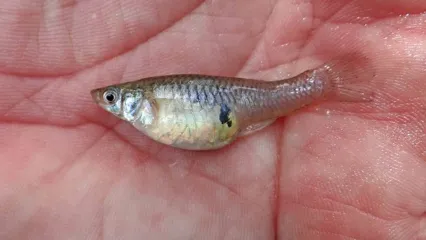
Description
The Western Mosquitofish (Gambusia affinis) is the only Oklahoma native member of the live-bearing fish family- Poecillidae.
Found throughout Oklahoma, the mosquitofish typically frequents quiet pools in small creeks and is also found in the shallow backwaters of larger creeks and river systems, where it can easily feed on small insects, fish eggs and amphibian larvae and some vegetative material. Like its common name suggests, this fish is a common predator of mosquitoes, and larger fish can feed on hundreds per day, though consumption rates are usually smaller. This fish's diet also includes crustaceans and other invertebrates.
Additionally, males have a much longer anal fin that is used for mating. All mosquitofish have a flattened head with the bottom lip extending past the top so the mouth is upturned, allowing the mosquitofish to feed by skimming the surface of the water. Although this upturned mouth and feeding method are features similar to the topminnow family, Fundulidae, the mosquitofish has fewer rays in the dorsal and anal fins and has a much more robust stomach than topminnows. Additionally, mosquitofish have a dark vertical line underneath the eye and another directly above the anal fin. This species also has a diamond-shaped net pattern that is obvious on most individuals, with a large eye and rounded speckled tail serving as secondary field marks.
In the past 100 years, the mosquitofish has been intentionally released in over 35 states and in several countries throughout the world as a way to manage mosquito populations and potential diseases associated with the biting insect. Unfortunately, many areas now report ecological setbacks due to the introduction and haven't seen as extreme of a decrease in mosquito populations as expected. Because mosquitofish are aggressive and opportunistic feeders - attacking other species of fish and feeding on fish and amphibian eggs- some species, including a chub native to Utah and various species of western frogs, have seen drastic population declines. The Oklahoma population of mosquitofish remains stable.
Size
Generally olive in color, these small fish only grow to about two inches, with males being smaller than females.
Life Cycle
Unlike other fishes native to Oklahoma, the mosquitofish produces live young. After mating, the females can store sperm for several months, but actual gestation typically lasts less than a month. While the average number of young produced per brood per female is around 60, some reports show larger females can brood up to 300. Although the ratio of males to females is generally one-to-one at birth, it later shifts towards females in the adult populations. Females can produce several broods per year and the average lifespan is three years.


